Did Transportation Money Decrease In The 1800s
6 Transportation Revolution
In this chapter we examine technological changes that improved Americans' ability to move people and goods, as well as the economic and political forces that helped shape the growth of transportation networks.

The transportation revolution in the United States began when Americans taking reward of features of the natural surround to move people and things from identify to place began searching for means to make send cheaper, faster, and more than efficient. Over time a series of technological changes immune transportation to advance to the betoken where machines take effectively conquered distance. People can almost effortlessly travel to anywhere in the world and tin inexpensively ship raw materials and products across a global market.
Just this engineering science is not ubiquitous, and it is non necessarily autonomous. As a famous science fiction author once said, the future is already hither, information technology's simply non very evenly distributed. Mod transportation infrastructure is controlled to a bully extent past large corporations, but the benefits of transport are depended on past anybody. And transportation applied science itself requires specific weather condition such as arable, cheap, portable energy in the form of fossil fuels, and public infrastructure created by our own and foreign governments, that even those large corporations depend upon merely don't control.
When we think of transportation, it is natural to recall first well-nigh going places. Getting on a plane in one hemisphere and getting off on the other side of the earth is a life-changing opportunity which was unavailable to almost people as piddling every bit a generation ago, and unthinkable two generations ago. Merely more crucial to our daily lives than the freedom offered by world travel is the cargo from the other side of the world that reaches us quickly in the holds of jets and more slowly but in nearly unimaginable volume in containers on ships. The global transportation of foods, raw materials, and finished appurtenances goes almost unnoticed in our daily lives, but makes our contemporary consumer lifestyle possible.

Although even the early stages of the transportation revolution allowed people similar seventy-yr former Achsah Ranney, from Affiliate Five'southward Supplement, to travel regularly between her children's homes in Massachusetts, New York, and Michigan, the more significant alter was the ability of her sons and of other Americans to motility freight from place to identify. The power to finer transport food and other goods to where they were needed allowed people to stay put, and even to concentrate themselves in cities in a manner they had never been able to do before. The growth of eastern cities depended just as much on the transportation revolution as did the building of new cities in the west.
As we have already seen, early Americans made amazing journeys with very archaic methods of transportation. The people who crossed Beringia and settled Northward and South America were able to embrace startlingly long distances on foot. European explorers crossed unsafe oceans to visit the Americas in tiny ships. Human being and creature power has been used extensively throughout American history, and is still used today to reach remote areas off the grid. Merely it is clear that improvements in transportation technology take been among the near powerful drivers of modify in our history. And the transportation revolution has certainly inverse our relationship with the American environment.
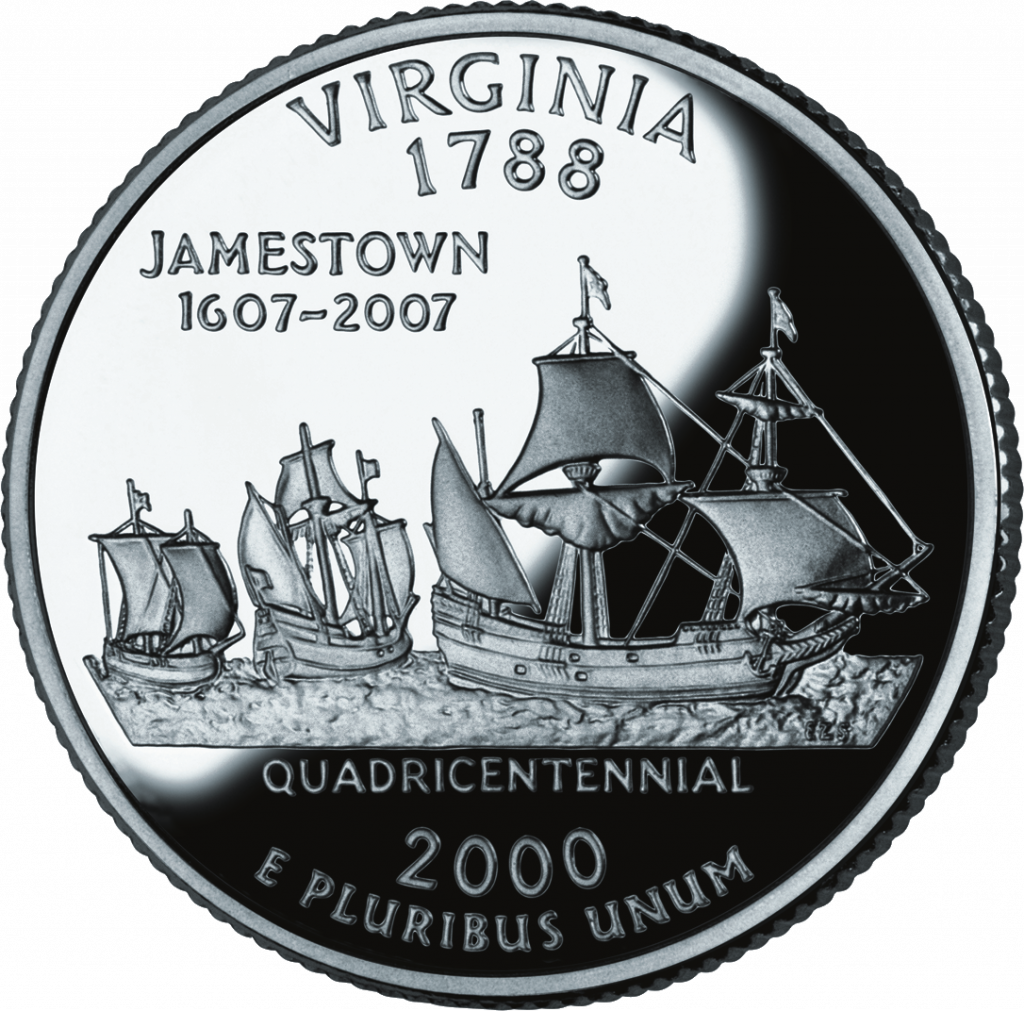
Technological improvements to ocean-going ships in the fifteenth century made European colonialism possible in the start identify. Ships became bigger, faster, and safer. More people and goods could leave the prophylactic of coastal waters and cantankerous the oceans, and the places these improved ships connected became centers of trade, population, and wealth. This pattern of growth repeated itself equally new technologies were developed to help Americans expand across the continent.
Equally nosotros have seen, American colonists depended on trade with England and with the sugar planters of the W Indies to make their outposts in New England and Virginia successful. Just from the beginning of the American Revolution to the decision of the War of 1812, relations between the new nation and United kingdom of great britain and northern ireland were tense and merchandise suffered. If it had non institute a way to ship people and goods to and from its own frontier, the United States would have remained a coastal nation focused on ports like Boston, New York, Philadelphia, and Charleston. The barely-remembered Whiskey Rebellion of 1791, when George Washington led United States troops against American farmers in western Pennsylvania, was really about transportation. Farmers west of the Appalachian mountains could not easily haul railroad vehicle-loads of grain to eastern markets, then they turned their harvests into a more portable product past distilling grain into whiskey. The farmers believed the government's excise revenue enhancement on distilled spirits had been instituted to bulldoze them out of the whiskey business organisation for the benefit of large Eastern distillers. Since they had few other sources of income, the tax was a serious issue for westerners. Luckily, the incoming Jefferson administration repealed the tax in 1801 and increasing Ohio River shipping provided new outlets for western produce.
Roads and Rivers
On the eve of the Revolution, the only road that did not hug the east coast followed the Hudson River Valley into western New York on its mode to Montreal (this was one reason colonial Americans seemed continually obsessed with the idea of conquering Montreal and bringing information technology into the The states). Less than xxx years later, riders working for the Post Office Section carried mail to nearly all the new settlements of the interior. The postal system's designer, Benjamin Franklin, understood that in lodge for the new Republic to part, information had to menstruum freely. Franklin set a low rate for mailing newspapers, insuring that news would broadcast widely in the newly-settled areas. Only it was i affair carrying saddlebags filled with messages and newspapers to the frontier, and something else moving people and freight.
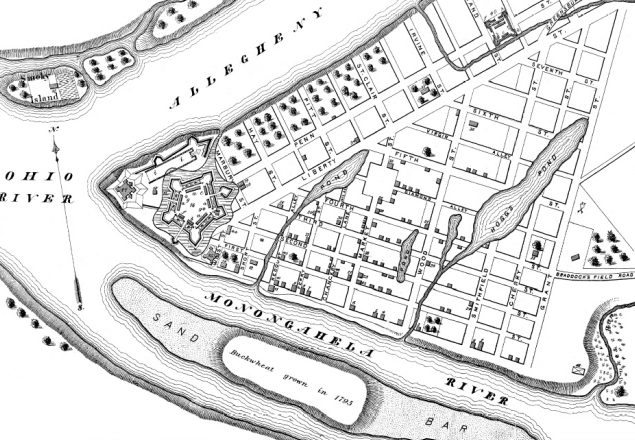
Rivers were the first of import routes to the interior of North America. The Ohio River, which begins at Pittsburgh and flows southwest to join the Mississippi, helped people get to their new farms in the Ohio Valley then helped them carry their farm produce to markets. The Ohio River Valley became one of the start areas of rapid settlement after the Revolution, along with the Mohawk River Valley in western New York. The importance of river shipping is illustrated by the fact that over fifty thousand miles of tributary rivers and streams in the Mississippi watershed were used to bladder goods to the port of New Orleans. The dependence of western farmers on the Spanish port also explains why New Orleans was a considered strategic urban center by the United states of america in the War of 1812. Thomas Jefferson's 1803 purchase of the Louisiana Territory had actually begun as an endeavour to purchase the city of New Orleans, and Andrew Jackson's defense of the port during the War of 1812 was vital to insuring the success of western expansion.
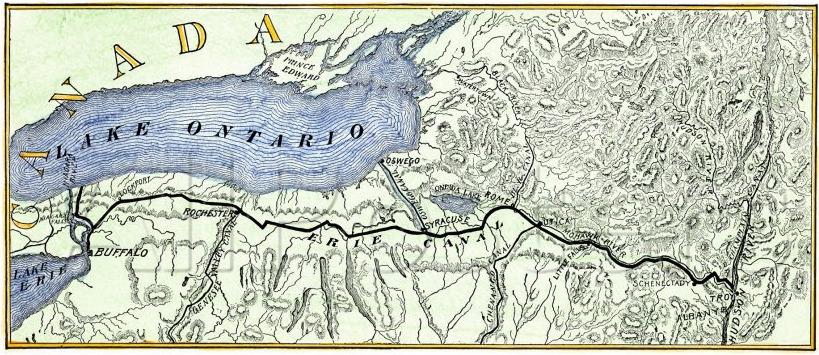
Early westward expansion depended on rivers, and towns and cities built during this era were normally on a waterway. Pittsburgh, Columbus, Cincinnati, Louisville, St. Louis, Kansas City, Omaha, and St. Paul all owe their locations to the river systems they provide access to. Buffalo, Cleveland, Detroit, Chicago, and Milwaukee utilize the Not bad Lakes in the same way. These lakeside cities exploded after the Erie Canal opened a route from the Great Lakes to the Atlantic, and allowed New York to overtake New Orleans as the nation's most important commercial port. The 363-mile Erie Culvert was then successful that some other 4 yard miles of canals were dug in America before the Civil War.
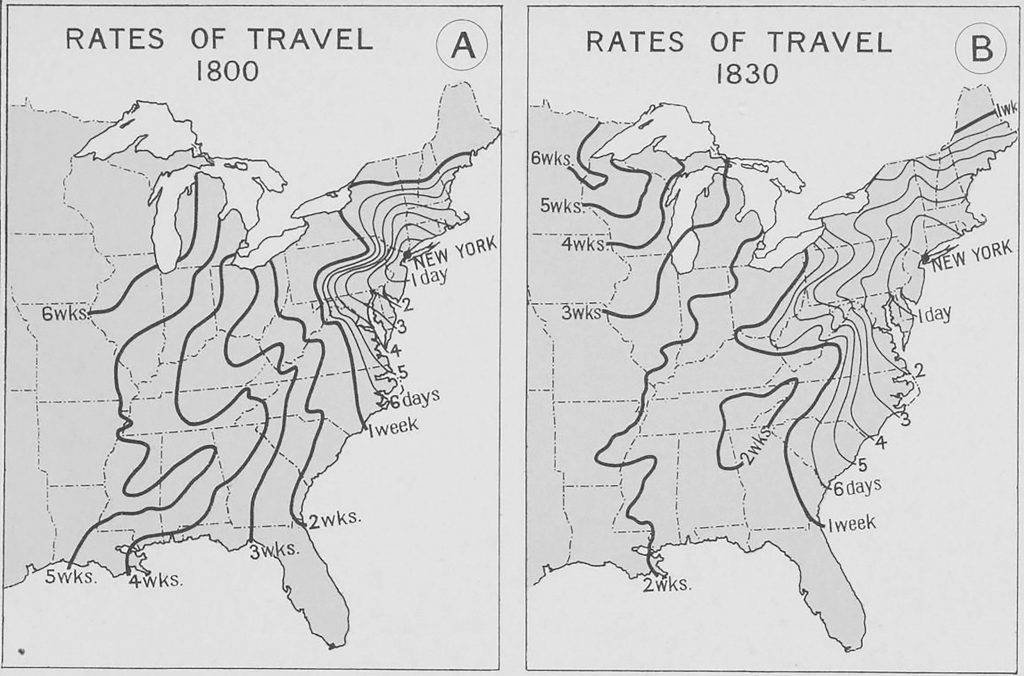
In 1800, it took nearly two weeks to reach Buffalo from New York City, a month to get to Detroit, and half dozen grueling weeks of travel to arrive at the swampy lake-shore settlement that would become Chicago. Thirty years subsequently, Buffalo was just 5 days away, Detroit about ten days, and Chicago less than three weeks. Horses pulled canal boats from towpaths on shore, eliminating the strain of travel for the boats' passengers. Floating along on at-home h2o was infinitely more comfy than spending weeks on a wagon, in a cramped phase motorcoach, or on horseback. The number of people willing to make long trips increased accordingly. And the amount of freight shipped to New York, afterward the culvert cut shipping costs by over ninety percent, increased astronomically. Goods flowed along the Canal in both directions, offer life-changing opportunities. Equally mentioned previously, within 10 years of the Erie Canal'southward completion, the last fulling mill processing homespun fabric in Western New York shut its doors. Women no longer had to spend their time spinning wool and weaving their own textiles to make their family's clothing. They could buy bolts of wool and cotton fiber fabrics from the same merchant at the local full general store who ground their family'due south grain into flour and shipped information technology on the Canal to eastern cities. With fewer demands on their time, many women were able to non only improve their own quality of life, but contribute to family income by taking in piece-work, raising greenbacks crops, or keeping cows and churning butter for sale to their local merchants.
The Age of Steam
Steam engineering inverse the nature of transportation. Until steam engines were put on riverboats, shipping had depended on either current of air and river currents or on human being and animal power. Goods could hands exist floated due south from farms on the nation'south rivers, merely it was much more difficult and expensive to transport products against the rivers' currents to the frontier. Flatboats and rafts accumulated at downstream ports, and were oftentimes broken down and burned every bit firewood. Steam engines fabricated it possible to sail upstream as easily and about every bit quickly equally down, causing an explosion of travel and shipping that radically changed frontier life.

Steam engines were a production of early European industrialism. The first steam patent was granted to a Spanish inventor named Jerónimo Beaumont in 1606, whose engine collection a pump used to drain mines. Englishman James Watt's 1781 engine was the showtime to produce rotary power that could be adjusted to drive mills, wheels, and propellers. Robert Fulton, an American inventor who had previously patented a canal-dredging motorcar, visited Paris and defenseless steamboat fever. Fulton sailed an experimental model on the Seine, and and so returned dwelling house and launched the commencement commercial American steamboat on the Hudson River in 1807. The Clermont was able to sail upriver 150 miles from New York City to Albany in 32 hours. In 1811, Fulton congenital the New Orleans in Pittsburgh and began steamboat service on the Mississippi.
Although Robert Fulton died simply a few years later of tuberculosis, his partners Nicholas Roosevelt and Robert Livingston carried on his business, and the age of riverboats was underway. Like Fulton's prototype and the Clermont, the New Orleans was a large, heavy side-wheeler with a deep draft. Information technology was not the virtually efficient blueprint for shallow water, and information technology did not have long for send-builders to settle on the familiar shallow-draft rear-paddle riverboats that carried freight on the Mississippi and its tributaries well into the 20th century. The shallower a riverboat'south typhoon, the farther upriver it could travel. Steam-powered riverboats soon pushed the transportation frontier to Fort Pierre in the Dakota territory and even to Fort Benton, Montana. Riverboats fabricated it possible to send goods in and out of most the whole area Thomas Jefferson had acquired in the Louisiana Purchase only a generation earlier. And steam-powered ocean shipping made the markets of Britain and Europe readily attainable to farmers and merchants in the middle of North America.
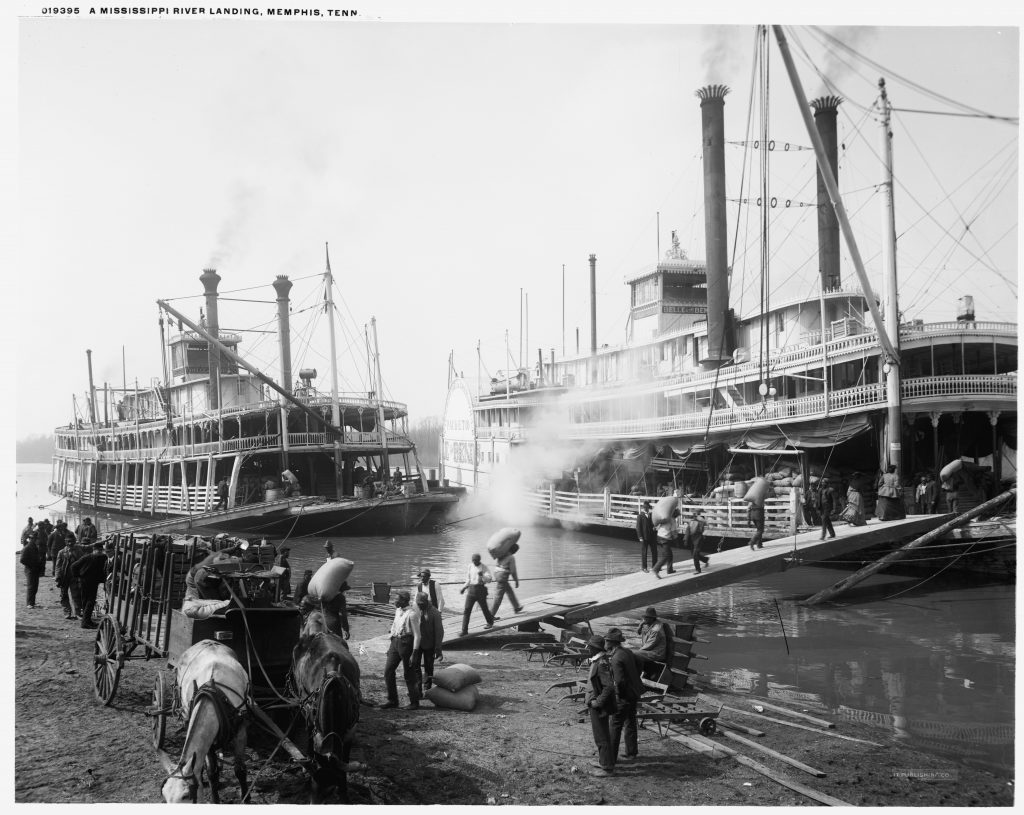
The other transportation engineering enabled by steam power, of course, was the railroad. But railroads were even more revolutionary than steamboats. In spite of their power and speed, steam-powered riverboats depended on rivers or occasionally on canals to run, but a railroad could be built almost anywhere. Suddenly, the expansion of American commerce was no longer limited by the routes nature had provided into the borderland.
America'due south first small-scale railroads had actually been congenital on the Eastward Declension earlier a steam engine was available to power them. Trains of cars were pulled by horses and looked a lot similar phase-coaches on rails. Merely later Englishman George Stephenson'due south locomotives began pulling passengers and freight in northwestern England in the mid-1820s, Americans speedily switched to steam. The first locomotive used to pull cars in the U.s. was the Tom Thumb, built in 1830 for the Baltimore and Ohio Railroad. Although Tom Thumb lost its maiden race against a horse-fatigued train, Baltimore and Ohio owners were convinced by the demonstration of steam engineering science and committed to developing steam locomotives. The railroad, which had been established in 1827 to compete with the Erie Culvert, already advertised itself as a faster manner to move people and freight from the interior to the declension. Adding steam engines accelerated rail'southward advantage over canal and river shipping.
Over 9,000 miles of runway had been laid by 1850, almost of information technology connecting the northeast with western farmlands. The Mississippi River was notwithstanding the preferred route to market from Louisville and St. Louis south. But Cincinnati and Columbus became continued by rail to the Swell Lake ports at Sandusky and Cleveland, giving the northern Ohio Valley faster admission to New York markets. Detroit and Lake Michigan were also connected by rail, making the long steamboat trip around the northern reach of Michigan's lower peninsula unnecessary.
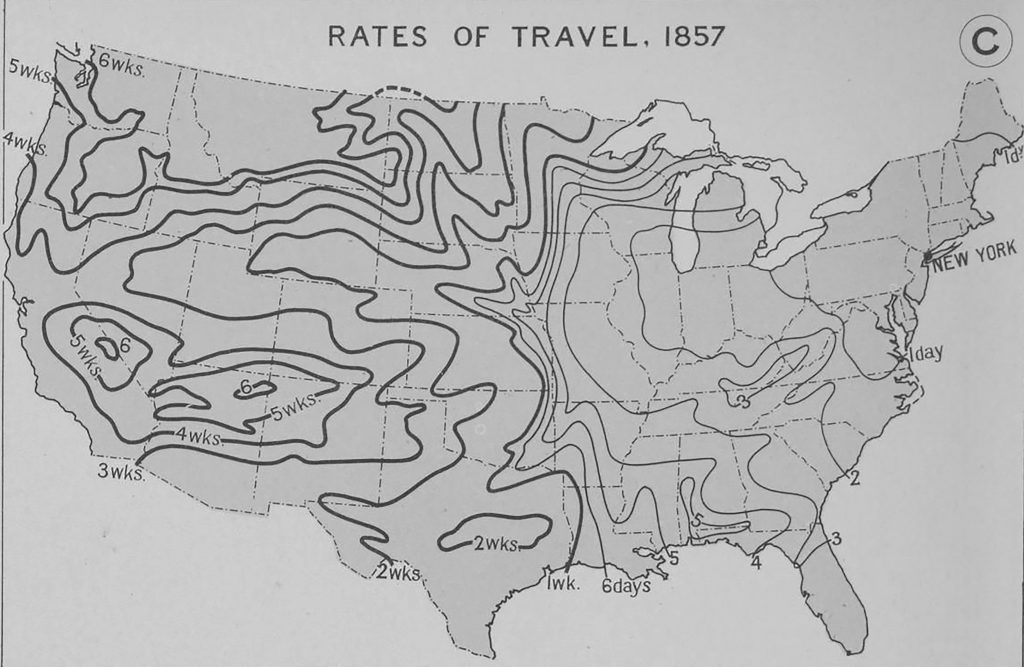
By 1857, rails travelers could reach Chicago in less than 2 days and could be almost anywhere in the northern Mississippi Valley in three. On the eve of the Civil War in 1860, Chicago was already becoming the railroad hub of the Midwest. The Illinois Fundamental Company had been chartered in 1851 to build a runway line from the pb mines at Galena to Cairo, where the Ohio and Mississippi Rivers joined. Galena is also located on the Mississippi on the northern border of Illinois, simply rapids due north of St. Louis made transporting ore on the river impossible, illustrating the advantage of rails over rivers. A railroad line to Cairo, with a branch line to Chicago, would also concenter settlers and investors to Illinois. Young Illinois attorney Abraham Lincoln helped the Illinois Central foyer legislators and receive the get-go federal land grant ever given to a railroad company. The visitor was given 2.6 million acres of land, and Illinois Senator Stephen Douglas helped design the checkerboard distribution of parcels that would become common for railroad land grants. The map below shows the extent of the land the government gave to the Illinois Central Visitor, which a few years later showed its gratitude past helping to finance Lincoln's Presidential entrada against Douglas.
The North's advantage over the Amalgamated South in railroad miles and the Union Army'due south power to move troops and supplies efficiently had a definite impact on the outcome of the Civil War. In the years following the war, the shattered South added very little railroad rails and repaired only a modest percentage of the tracks the Union Army had destroyed during the war. While railroads languished in the South, rail miles in the North exploded. In 1869, the West Coast was connected through Chicago to the Northeast, when the Marriage and Central Pacific Lines met at Promontory Point Utah on May tenth. The building of a transcontinental railroad was fabricated possible by the Pacific Railroad Human action, which President Lincoln had signed into law in 1862.
Public or Private?
The Pacific Railroad Deed was the first police allowing the federal regime to give land directly to corporations. Previously the government had granted land to united states of america for the benefit of corporations. The Human activity granted 10 square miles of land to the railroad companies for every mile of rails they built. State next to railroads always increased in value. The unprecedented gift of ten square miles of rapidly-appreciating country for every mile of track was a tremendous incentive to railroad companies to lay simply as much track as they possibly could. Decisions to build lines were oft based on the land granted, rather than on whether or not railroad companies expected the new lines to comport enough traffic or generate enough freight acquirement to pay for themselves. In the eighteen years between the original Illinois Primal grant of 1851 and the completion of the transcontinental line in 1869, privately-owned railroads received nigh 175 meg acres of public land at no cost. This amounts to nigh seven percent of the country area of the contiguous 48 states, or an expanse slightly larger than Texas. For comparing, the Homestead Act distributed 246 million acres to American farmers over a 72-year menstruation between 1862 and 1934, only required homesteaders to alive on and to farm the land continuously for five years or pay for their parcel. The justification for the residency requirement was that the government was concerned homesteaders would become speculators and flip their farms. Railroad land grants were made with no like stipulations because railroad corporations were expected to sell the lands they were given at a substantial profit.

It has often been argued that a national infrastructure project as large as a transcontinental railway could never accept been built without government assistance. The West Coast and western territories needed to be brought into the Union, some historians have argued, and the only way to achieve this was with authorities-supported railroads. Ironically, the same people who make this argument usually also claim that it would have been disastrous for the government to have owned the railroads it had made possible with its legislation, loans, and land grants. An undertaking of this scope and scale, they say, requires that corporations be given monopolies and grants of natural resource and public credit. These arguments make it seem inevitable that giant corporations taking huge gifts from the public sector were the only manner for America to move forward and build a rail network. Still, history shows that this was not the only style a national rail system could have been built.
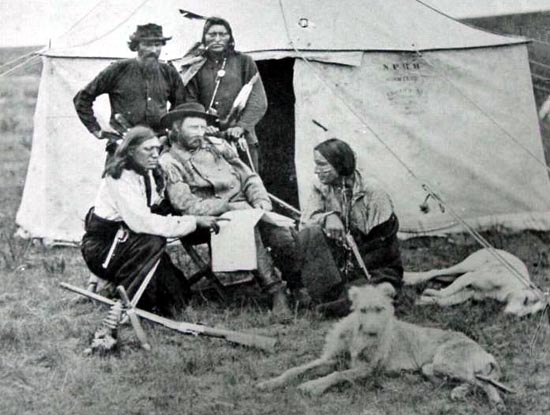
There are numerous examples of rail systems built and managed past the public sector in foreign countries, especially during the nineteenth century when nearly every rail system outside the U.s. was state-owned and operated. However, for the sake of simplicity we will restrict the comparing to the United States. The Northern Pacific Railway, a individual corporation chartered past Congress in 1864, built vi,800 miles of track to connect Lake Superior with Puget Sound. In return, the corporation was given 40 million acres of land in l-mile checkerboards on either side of its tracks. Not only did the Northern Pacific rely on the regime for land and financing, the railroad used the services of the U.S. Ground forces to protect its surveyors and to move uncooperative Indians out of its way. When the Northern Pacific's proposed route cut through the center of the Great Sioux Reservation, established by the 1868 Fort Laramie Treaty, the corporation pressured the government to break the treaty. George Custer announced that gold had been discovered in the Black Hills after an 1874 mission protecting Northern Pacific surveyors, and Washington let the treaty be disregarded past both the railroad and the prospectors. The Indians responded with the Cracking Sioux War of 1876, which culminated in the Boxing of Little Big Horn, where Custer and his 7th Cavalry were wiped out by Sitting Bull and Crazy Horse leading a strength of Lakota, Cheyenne, and Arapaho warriors. But although the Indians won the battle, they lost the state of war. Less than a year afterwards, Sioux leaders ceded the Black Hills to the United States in substitution for subsistence rations for their families on the reservation.
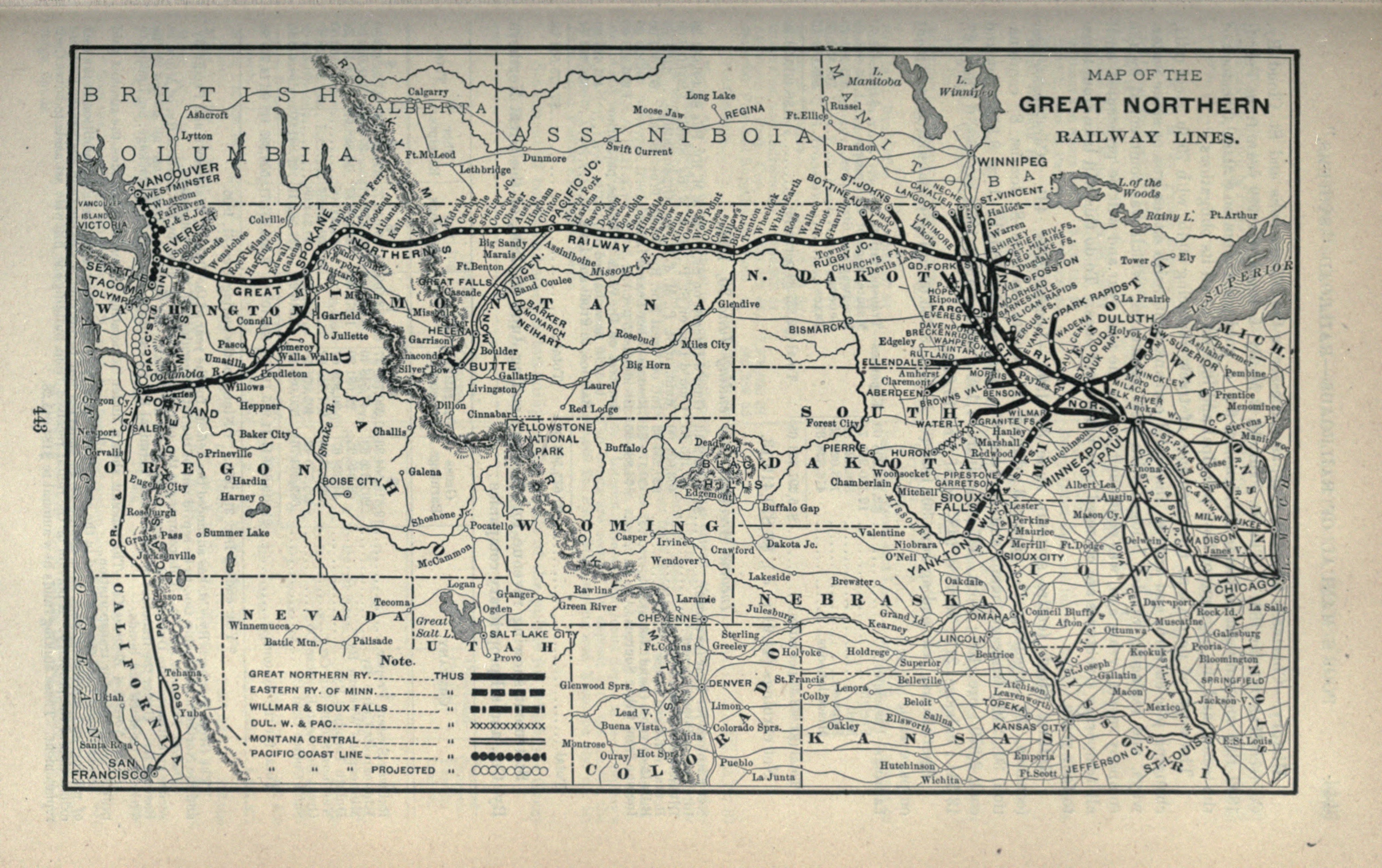
In dissimilarity, Canadian-American railroad entrepreneur James Jerome Hill built his Great Northern Railroad line from St. Paul to Seattle during the last decades of the nineteenth century without causing a war and without receiving a single acre of gratis public state. The Not bad Northern bought country from the government to build its right of way and to resell to settlers. Hill claimed proudly that his railway was completed "without any authorities help, even the right of mode, through hundreds of miles of public lands, beingness paid for in greenbacks." The Peachy Northern system continued the Northwest with the rest of the nation through St. Paul, using a web of over 8,300 miles of track. And because Hill only built lines where traffic justified them rather than adding runway just to collect free country, the Dandy Northern was i of the few transcontinental railroad companies to avoid defalcation in the Panic of 1893.
Regardless of the ways they were financed and built, the proliferation of railroads caused explosive growth. Chicago was a frontier village of 4,500 people in 1840. When Lincoln helped the Illinois Key receive the first land grant in 1851, the city'south population was most xxx,000. Twenty years later Chicago was the centre of a speedily-growing railroad network, and the metropolis held x times the people. In 1880 Chicago'due south population was over 500,000, and ten years later Chicago had over a one thousand thousand residents. Nosotros will take a closer look at the changes railroads brought to Chicago in a Chapter Seven.
Internal Combustion
America's transportation revolution did non end with steamboats and railroads and was not limited to public transportation technologies. The development of the automobile ushered in a new era of personal mobility for Americans. Internal combustion engines were inexpensive to mass produce and much easier to operate than steam engines. With the evolution of automobiles and trucks around the turn of the twentieth century, it no longer required a huge majuscule investment and a team of engineers to purchase and operate motorized transportation. Fifty-fifty the workers on Henry Ford's associates lines could aspire to owning their ain Model Ts, particularly after Ford doubled their wages to $five a twenty-four hours in Jan 1914.
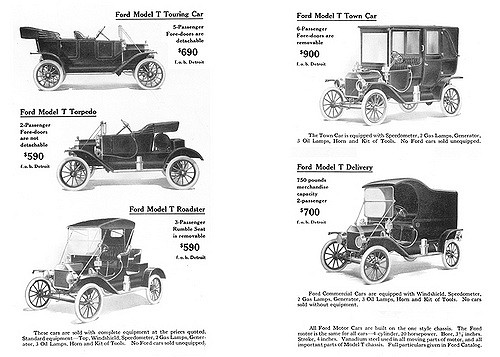
Engineers had experimented with building smaller machines using steam engines, and there were several examples in Europe and America of successful steam-powered farm tractors, trucks, and fifty-fifty a few horseless carriages. But internal combustion engines delivered much greater power relative to their mass, assuasive smaller machines to do more work. The first internal combustion farm tractor was built past John Froehlich at his small Waterloo Gasoline Traction Engine Company in 1892. Others began applying internal combustion to subcontract equipment, and between 1907 and 1912 the number of tractors in American fields rose from 600 to 13,000. Eighty companies manufactured more 20,000 tractors in 1913. Later on an auspicious first, Froehlich'southward little Iowa company grew slowly and began building subcontract tractors in book only after World War I. The Waterloo visitor built a good product, and was acquired by the John Deere Plow Company in 1918. Deere remains the globe leader in self-propelled farm equipment.
The kickoff internal combustion truck was built by Gottlieb Daimler in 1896, using an engine that had been developed by Karl Benz a yr earlier. World State of war I spurred innovation and provided a ready market place for internal combustion trucks that were much less expensive than their steam-powered rivals. Past the end of the war gasoline-powered trucks had overtaken the steam truck market. Well-nigh large trucks now burn diesel fuel rather than gasoline, using a compression-ignition engine blueprint patented by Rudolf Diesel in 1892.
Internal combustion trucks and tractors, like cars, allowed people to go farther, carry more than, and do more than piece of work than had been possible using human being and fauna power. And they were much more affordable than comparable steam-based vehicles and easier to build at a scale that encouraged private apply and ownership. Trucking somewhen challenged rail send, especially afterwards the evolution of semi-trailers and the Interstate Highway System. Although the beginning diesel truck engines but produced v to seven horsepower, they advanced quickly. Indiana mechanic Clessie Cummins built his start, six-horsepower diesel engine in 1919. The business bearing his name is now a global corporation doing $xx billion in annual business, mostly in diesel engines. Cummins's electric current heavy truck engine is rated at 600 horsepower.

While information technology is easy to focus on the inventions and technological innovations of the internal combustion era, we should not lose sight of the infrastructure improvements that made these innovations valuable. Without paved roads to run on, at that place would have been far fewer cars and trucks and their impact on order and the environment would take been much different. The biggest road-building project in American history was the construction of the Interstate Highway Organization, financed by the Federal-Aid Highway Acts of 1944 and 1956. Unlike the transcontinental railroad projection of the 1860s, the Interstate Highway Organization was paid for by the federal government and the roads are owned by usa. The system includes most 47,000 miles of highway, and the project was designed to be self-liquidating, then that the price of the system did not contribute to the national debt. In addition to the Interstate Organisation, American states, counties, cities and towns maintain systems of roads totaling nearly iv million miles, near two-thirds of which are paved.
Gasoline vs. Ethanol
The economic trade-off of internal combustion for the farmers and teamsters who starting time adopted information technology was that speed and power came at a price. Where horses and oxen were readily available in farm communities and were cheap to maintain, tractors and trucks were a substantial investment. And dissimilar horses and oxen, tractors and trucks needed to be fueled with petroleum that made them dependent on a faraway industry. However, this dependence was not inevitable. Henry Ford and Charles Kettering, the chief engineer at Full general Motors, had both believed that equally engine compression ratios increased, their companies' engines would transition from gasoline to ethyl alcohol. We are all aware that the shift to ethanol did not happen, but why it did not is less well-known and may surprise you.

Most history books faithfully repeat the inaccurate story that Edwin Drake's famous 1858 oil strike in Titusville Pennsylvania came just as the world was running out of expensive whale oil. Actually, there was a thriving market for booze fuel in the mid-nineteenth century United States. Ethanol was toll-competitive with kerosene, and unlike kerosene information technology was produced by many small distillers, creating widespread competition that would proceed to drive down prices. Unfortunately for ethanol producers and fuel consumers, the alcohol fuel industry was wiped out when the Lincoln assistants imposed a $2.08 per gallon tax on distilled booze betwixt 1862 and 1864. A gallon of Standard Oil kerosene still cost only 58 cents, so kerosene took over the American fuel marketplace. Of course, after kerosene became the only bachelor fuel, Standard Oil was complimentary to raise prices as it saw fit.
Merely ethanol notwithstanding had its advocates. The very starting time American internal combustion engine, built in 1826 by Samuel Morey, had used grain alcohol because it was cheap and readily available. Almost a century later, Henry Ford'due south Model T was designed to be convertible betwixt kerosene, gasoline, and ethanol. Full general Motors chief engineer Kettering was convinced it was merely a matter of time until ethanol became the fuel of choice.
So why aren't we all driving cars running renewable fuels? Part of the answer, as yous have probably already guessed, is that Standard Oil made the auto industry an offer they couldn't refuse. The oil company used its vast distribution network to brand gasoline available everywhere it was needed, and insured that the cost was so low that competitors could not profit if they entered the market. Standard Oil pioneered the do of pricing beneath their cost of production to run competitors out of the business concern. The profits of the visitor'southward many other divisions subsidized their short-term losses on gasoline. Predatory pricing was one of the principal charges made confronting the company in the 1911 antitrust case that resulted in the breakup of the Standard Oil Trust.

Just Standard Oil's predatory pricing does not tell the whole story of why we do non run cars on ethanol. The rest of the story, if anything, is even more sinister. Information technology has long been known that using gasoline at loftier compression results in engine knocking. It was also well-known that ethanol did non knock. Charles Kettering at General Motors had argued for years that the "nigh directly route which we at present know for converting energy from its source, the dominicus, into a fabric suitable for utilise as a fuel is through vegetation to booze." The applied science was uncomplicated and Americans had been distilling alcohol fuels for generations. Unfortunately, Kettering worked for a corporation whose major shareholder was the Du Pont family, who besides happened to own the largest corporation in the chemical industry. It would be impossible for DuPont to turn a profit or for General Motors to gain a competitive advantage using alcohol fuels, since the distilling technology was universally available and the product was united nations-patentable. However, in that location was an extremely profitable alternative.
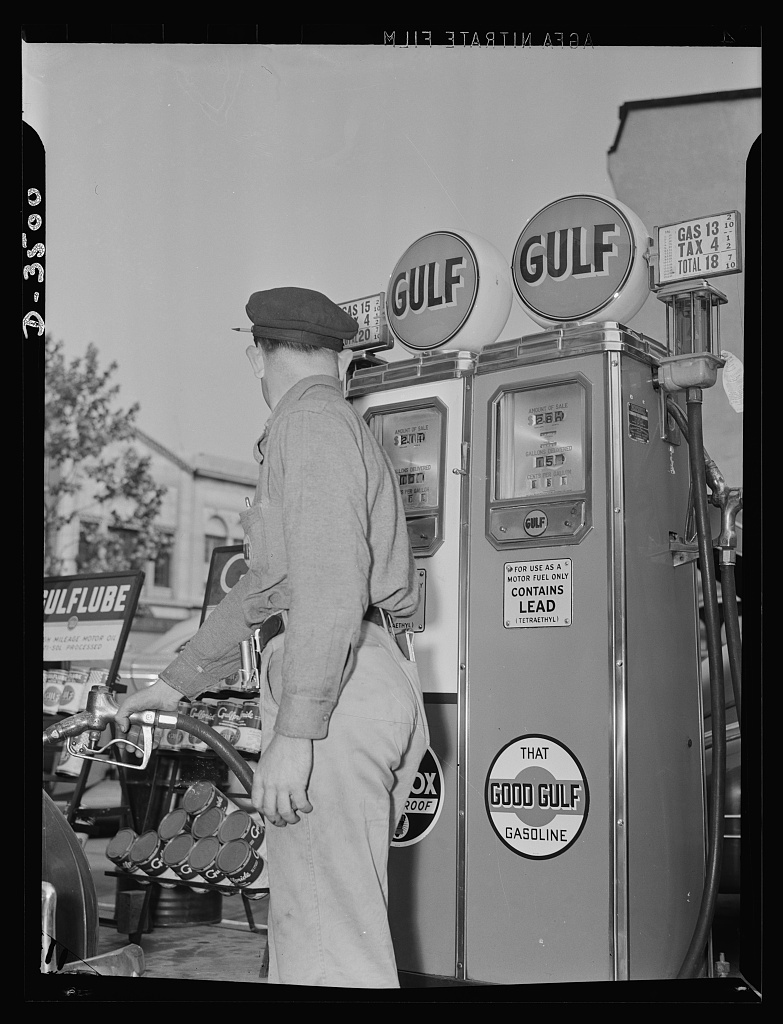
Tetraethyl Lead (TEL) was a lubricating compound that could be added to gasoline to eliminate knocking. General Motors received a patent on its employ every bit an anti-knock agent, and Standard Oil was granted a patent on its industry which was later on extended to include DuPont. The 3 companies founded Ethyl Corporation to market TEL and other fuel additives. Unfortunately, pb is a powerful neurotoxin, linked to learning disabilities and dementia. The federal regime had misgivings nigh allowing lead additives, and in 1925 the Surgeon General temporarily suspended TEL's utilize and government scientists secretly approached Ford engineers seeking an alternative. In the 1930s, 19 federal bills and 31 state bills were introduced to promote booze use or blending. But the American Petroleum Industries Commission lobbied difficult against them. Under intense industry pressure level, the Federal Merchandise Committee even issued a restraining order forbidding commercial competitors from criticizing Ethyl gasoline as unsafe. By the mid-1930s, ninety percent of all gasoline contained TEL. Airborne lead pollution increased to over 625 times previous groundwork levels, and the average IQ levels of American children dropped 7 points during the leaded-gas era. Past the 1980s, over l million American children registered toxic levels of lead absorption and 5,000 Americans died annually of pb-induced heart disease. When public concern continued to increment, the Ethyl Corporation was sold in 1962 in the largest leveraged buyout of its fourth dimension. In the 1970s the newly-established Environmental Protection Agency finally took the stand up other federal agencies had been afraid to take. The EPA declared emphatically that airborne pb posed a serious threat to public health, and the government forced automakers and the fuel manufacture to gradually eliminate the utilise of lead. TEL is now illegal in automotive gasoline, although information technology is still used in aviation and racing fuels. Unleaded gasoline is now used in all new internal combustion cars. Only while pure ethanol has powered most automobiles in Brazil since the 1970s, most Americans go along to utilize a blend containing just 10% ethanol to ninety% gasoline.
Global Cargo
Two additional forms of transportation became increasingly important every bit the twentieth century concluded and the twenty-get-go century began. Commercial airplanes are only a footling over a hundred years old and the first air cargo and airmail shipments were flown in 1910 and 1911. Air cargo was considered besides expensive for all simply the near valuable shipments until limited carriers such equally UPS and Federal Express revolutionized the aircraft business in the 1990s. The global economy now measures air freight volumes in ton-miles. In 2014, the world shipped more than 58 billion ton-miles of goods. Air freight also allows perishable items like fresh fruits and vegetables to be transported across oceans and continents from producers to consumers. This is a large business. Over 75 million tons of fresh produce are air-shipped annually, worth more than $l billion.
For nonperishable items, container aircraft has created a unmarried global market. Standardized containers were invented past a trucker named Malcolm McLean, who realized it would save a lot of time and energy if his trucks didn't need to be loaded and unloaded at the port, but could merely be hoisted on and off a cargo transport. McLean refitted an oil tanker and made his first trip in 1956, conveying l-eight containers from Newark to Houston. Current annual shipping at present exceeds 200 million semi-trailer sized containers. Containers can be shipped by ocean, rail, truck, and fifty-fifty air, allowing just-in-time operators like Wal-Mart to manage a supply chain that relies much less on warehoused inventory, and more than on product in transit.
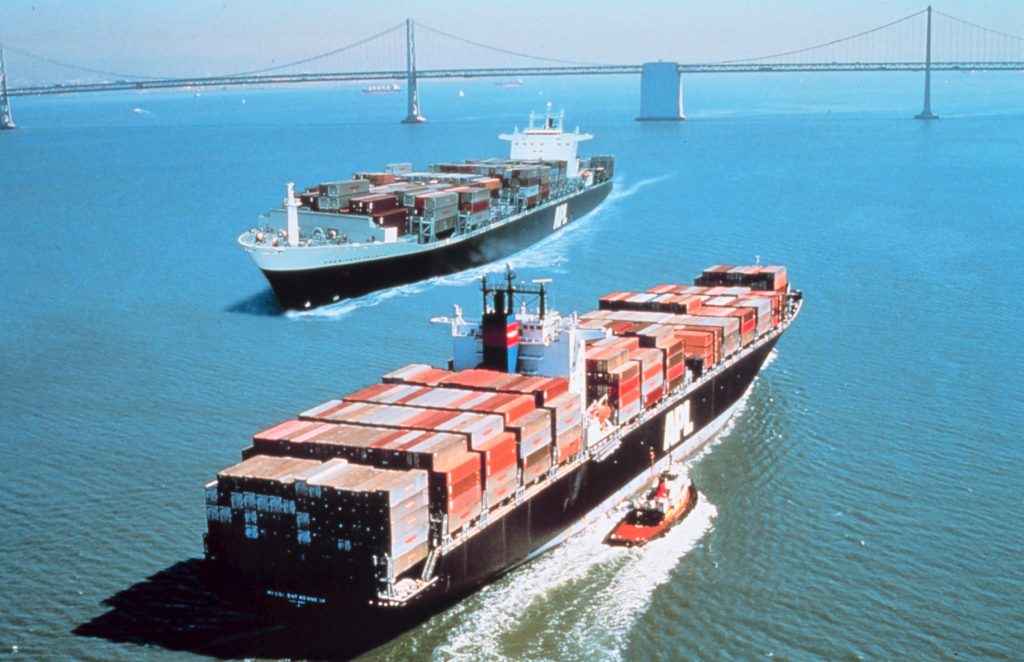
Only just equally shifting from horse power to a gasoline truck or tractor a hundred years ago involved economical merchandise-offs, shopping at Wal-Mart today introduces a new level of dependence. We non just rely on transportation systems and the fuels they run on, but too on supply-concatenation software, international trade agreements and currency fluctuations, and even on the political situations of faraway nations. Equally long as the costs of inputs like fuel and infrastructure like ports, highways, and open borders remains low, the global market place is a bang-up deal for the consumer and a source of immense profits to businesses and their shareholders. But a visitor like Wal-Mart is simply as dependent on factors information technology cannot control as its customers are. If any of these factors change, who will bear the cost?
Farther Reading
Bill Kovarik, "Henry Ford, Charles Kettering and the Fuel of the Future," Automotive History Review, Spring, 1998. Available online at world wide web.environmentalhistory.org
Marc Levinson, The Box: How the Shipping Container Fabricated the World Smaller and the World Economic system Larger, 2006.
Vaclav Smil, Creating the Twentieth Century: Technical Innovations or 1867-1914 and their Lasting Touch, 2005
George Rogers Taylor, The Transportation Revolution, 1815-1860, 1977.
Source: https://mlpp.pressbooks.pub/americanenvironmentalhistory/chapter/chapter-6-transportation-revolution/
Posted by: sandlinbervelp82.blogspot.com

0 Response to "Did Transportation Money Decrease In The 1800s"
Post a Comment